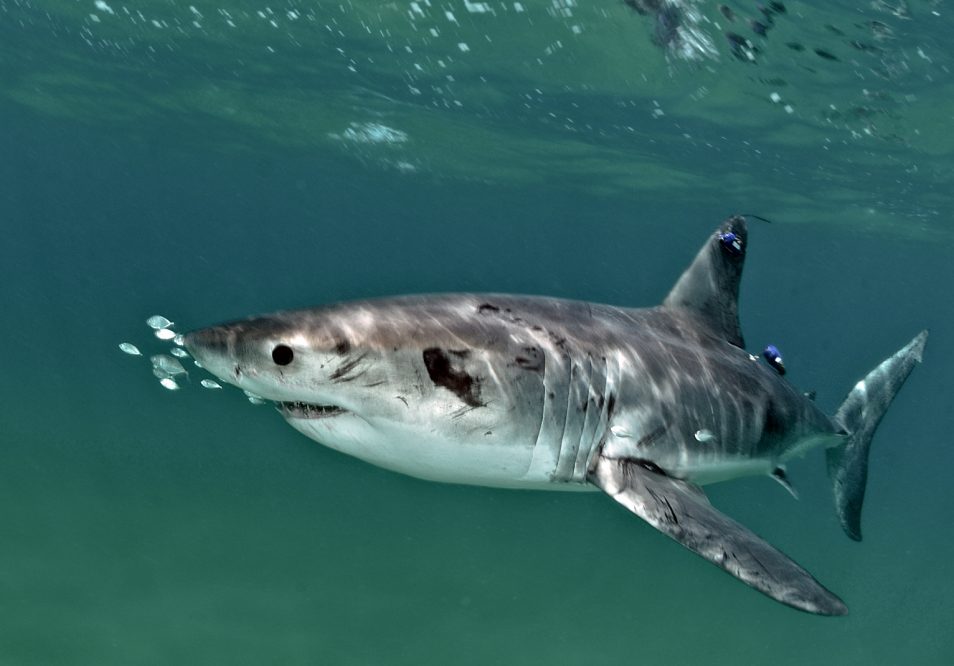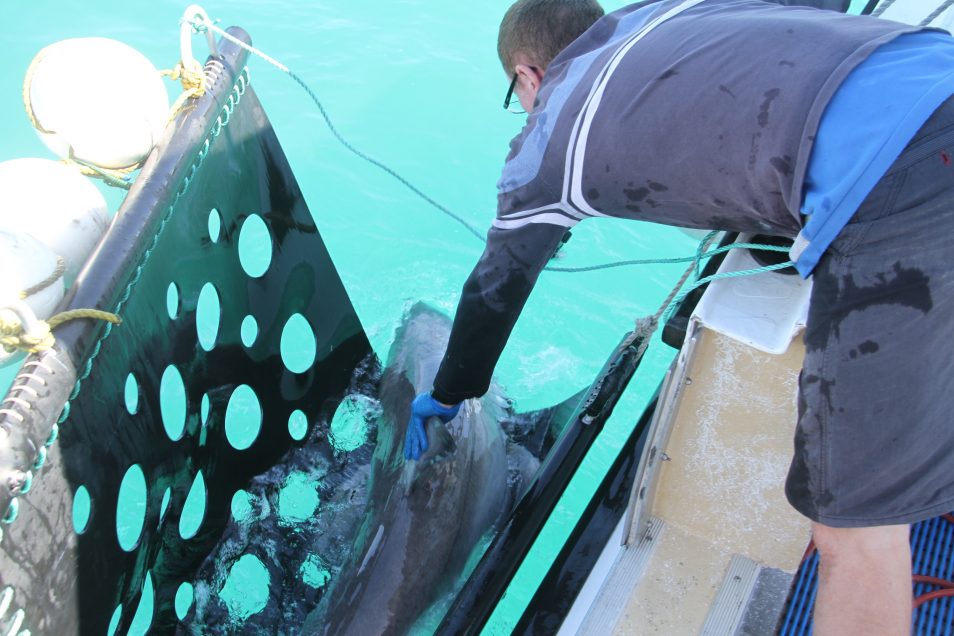
Tagging white sharks provides valuable information on their movement and can give insights for management and protection of the species. Photo credit: Justin Gilligan
Doo doo doo doo doo doo you want to learn about baby sharks?
Don’t worry – it’s not the viral Korean produced children’s song dividing parents worldwide that we are on about here. We’re talking about the real thing. Eastern Australia’s juvenile white sharks to be precise.
Our scientists have been collaborating on research to understand where juvenile white sharks, aged one to five-years-old, travel along our east coast, and how their movements change depending on their age or sex.
The team examined the movements of 43 individual juvenile white sharks on the east coast of Australia. And they discovered that they have quite complex movement patterns.
They found that they travel from as far north as the southern Great Barrier Reef to Tasmania, and across the Tasman Sea to New Zealand. That’s some distance! 13 degrees of latitude, or 1450 kilometres, to be exact.
KEY POINTS
- Sharks have complex movement patterns over thousands of kilometres
- As juvenile sharks mature, their latitudinal (north-south) range can increase
- Female sharks are more commonly found closer to the shore
- Acoustic tags extend the length of data on sharks, which is useful given their relatively slow reproductive cycle
Advantage receiver
Through advances in satellite and acoustic tagging technology, we’ve been able to create a comprehensive picture of juvenile shark movements over a seven-year period, with some individual sharks recorded for tracking periods of up to five years. This is a longer time period than we’ve ever measured before, providing new insights into the species.
Between 2008 and 2015 we tagged juvenile while sharks at Port Stephens in central New South Wales, and near Corner Inlet in southeast Victoria. When we tagged the sharks we also recorded some physiological information, including their size and sex. Our team placed a series of acoustic receivers in the water around where we tagged the sharks. When the tagged sharks swam past the receivers were pinged it provided a data point on their whereabouts.
We supplemented our shark movement information with data extracted from Australia’s Integrated Marine Observing System (IMOS) which collects animal tag detections from acoustic receivers across Australian waters – they track more than just white sharks by the way!

Releasing a juvenile white shark after deploying an acoustic and a satellite tag at Corner Inlet, Victoria. Photo credit: Kent Stannard.
One shark. Two sharks. White shark. Where sharks?
So where are our east coast white sharks travelling? Although the sharks were detected up and down the coast all year long, we noticed some seasonal differences.
During the winter-spring months, the sharks were in the more northerly regions of their range. And during the summer-autumn months, sharks were more common in the southern region.
While our data can’t tell us exactly why the sharks are spending their winters up north and their summers further south, some other studies provide insights. They have suggested that sharks might be following their food source as it moves with sea temperature changes. Or temperature may be a factor for juveniles who improve their ability to regulate their body temperature as they grow. Bigger sharks are be better at regulating their own body temperature and hence travel further distances.
Our data does show however that not all juvenile white sharks adhere to the seasonal north-south movement cycle along Australia’s east coast.
In the Port Stephens white shark nursery area (where we did most of the tagging) we found that the juveniles were staying in the area for an average of 62 days per year. They were not all there at the same time however, with juveniles detected at this location every month of the study period.

One of our researchers implanting an acoustic tag into a juvenile white shark at Corner Inlet, Victoria. Photo credit: Kent Stannard
The outliers
Not all of the white sharks we tagged adhered to the same patterns as the others.
The Ron Clarke of juvenile sharks, representing the greatest distance travelled, journeyed 8500 km in just 536 days. A marathon effort if you ask us!
Only one tagged juvenile shark reported on in this study travelled all the way to New Zealand. And another took a look 500 km off Australia’s coastline…then came back. These individuals were two of the largest sharks measured at tagging, and contribute to the finding that as sharks age they tend to travel larger distances and move further offshore.
Our study has also confirmed previous research into Australia’s two white shark populations.
That’s right, there are two distinct populations: The eastern population (ranging along the coast from Tasmania to central Queensland) and the southern-western population (ranging from western Victoria to northwestern Western Australia).
In this study of juvenile sharks tagged on the east coast, no sharks were recorded travelling west of the Bass Strait – confirming that these two populations rarely mix.
Lady sharks
In terms of differences in sex, we detected significantly more juvenile females closer to shore at Port Stephens. This result aligns with data coming from shark control programs that have identified more captured females in inshore areas. This sex-based difference has implications for management if more females are vulnerable to coastal threats and inshore pressures.
Mummy shark. Daddy shark.
This study didn’t look at the movements and distribution of adult sharks, but it did allow our researchers to collect a genetic sample of the juveniles to use in other research.
Understanding the life history (found in genetic samples) of juvenile sharks is what allows us to derive a total population estimate.
Using a technique called Close-kin Mark-Recapture, we previously estimated that the total east coast adult white shark population was 750 (with an estimated range between 470 and 1030). We estimated around double that number in the southern-western population.
Estimating the trend in total population size for both shark populations requires sampling and analyses, developing methods and continued collaboration with our partners. This will help to inform policy and conservation efforts for white sharks in Australia.
CSIRO and our partners play a key role in providing scientific evidence to deliver on aspects of the Australian White Shark Recovery Plan. Our research has included the development of new technology to estimate the total number of Aussie white sharks.
It’s the end! Doo doo doo…
This research was conducted with the NESP Marine Biodiversity Hub and IMOS in collaboration with the New South Wales Department of Primary Industries. The paper ‘Broad-scale movements of juvenile white sharks (Carcharodon carcharias) in eastern Australia from acoustic and satellite telemetry’ was published on 6 June 2019 in the Marine Ecology Progress Series.

